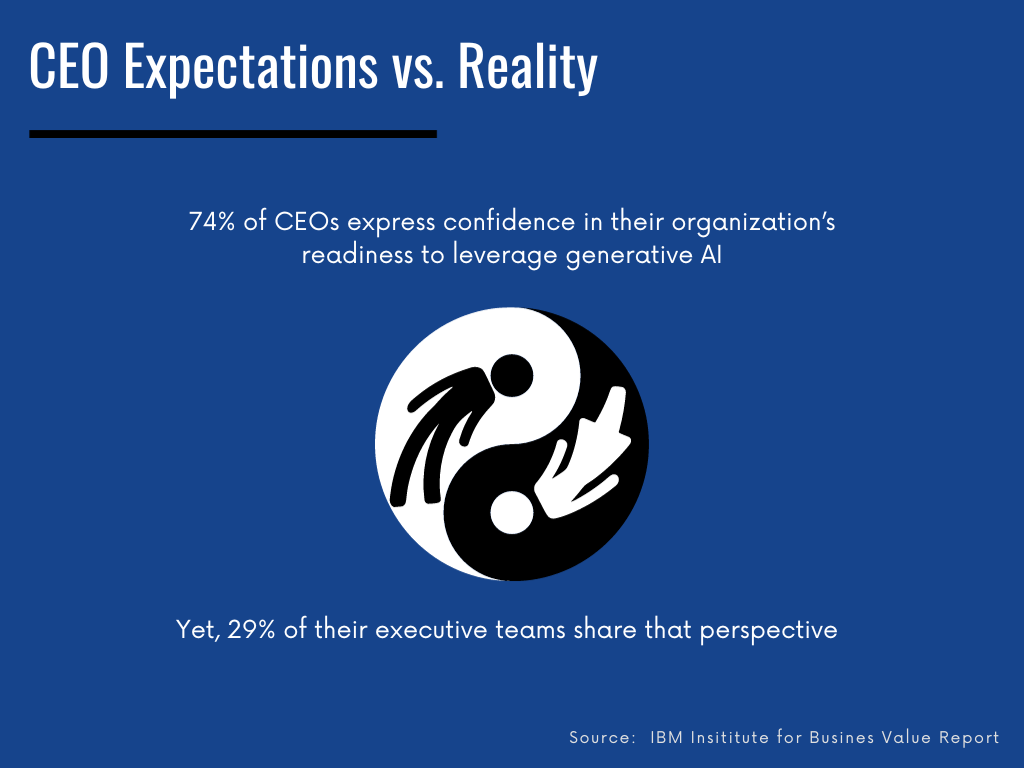Generative AI is emerging as a significant tool, offering the potential to innovate and streamline various processes. Its applications are vast, ranging from automating routine tasks to creating sophisticated models for prediction and analysis. As such, it’s seen by many as a catalyst for the next wave of digital transformation.
Yet, a discernible discrepancy exists between the high hopes of CEOs and the actual readiness of their organizations to adopt this technology.
A report by the IBM Institute for Business Value has brought this issue into focus, suggesting that a strategic emphasis on practical use cases is essential for the effective employment of generative AI.
Bridge The Gap
Many CEOs view generative AI as a key to unlocking future growth and innovation. Approximately 74% of surveyed by IBM express confidence in their team’s ability to leverage this technology. This optimism is based on the belief that generative AI will lead to improved efficiency, better customer experiences, and new revenue streams.
However, other C-suite executives exhibit more reservation, with only 29% sharing their CEOs’ confidence levels. This gap suggests a potential misalignment between leadership’s expectations and the practical capabilities of their teams. It also raises questions about the preparedness of organizations to integrate generative AI into their existing workflows.
As such, the Chief Information Officer (CIO) plays a pivotal role in bridging the gap between the CEO’s vision for generative AI and the organization’s operational reality. As the executive responsible for managing and implementing technology, the CIO is uniquely positioned to translate high-level strategic goals into actionable tech initiatives.
In the context of generative AI, the CIO’s responsibilities become even more critical as they involve identifying the right opportunities for integration that align with business objectives.

Resource Constraints
The IBM report indicates that the workforce’s skills will need to evolve alongside generative AI’s integration into business processes. While technical skills remain important, there is an increasing emphasis on creativity and the ability to collaborate with AI systems. By 2025, these skills are expected to be in high demand across all levels of employment.
While CEOs recognize the need for new skills, there is often a disconnect when it comes to the availability of resources to close the skills gap. Budget constraints, competing priorities, and a lack of clear strategy can leave organizations ill-prepared to develop the talent required for a generative AI-driven future.
Allocating resources for skills development is a challenge that requires CEO support. Investment in learning and development is essential, and the CEO and CIO must ensure that it is treated as a strategic priority.
Strategic Actions for CEOs
The partnership between the CEO and CIO is essential for the successful deployment of generative AI. This collaboration ensures that the organization’s technology strategy is not only ambitious but also grounded in practicality. Together, they can assess the organization’s readiness, identify skill gaps, and set a realistic timeline for adoption and scaling of generative AI solutions.
The CEO and CIO must work together to ensure that initiatives are not only technically feasible but also offer strategic value. This involves:
Identification of Impactful Use Cases: CEOs should start by identifying a select number of use cases where generative AI can have a substantial impact. This requires a thorough analysis of the organization’s processes to determine where AI can provide the most value.
Alignment of AI Initiatives with Business Goals: It is crucial that the selected use cases for generative AI are aligned with the company’s broader business objectives. This alignment ensures that AI initiatives are strategically relevant and contribute positively to the organization’s overarching goals.
Roadmap Development: A clear and detailed roadmap for generative AI initiatives is crucial. This roadmap should outline the steps needed to go from concept to implementation, including timelines, milestones, and key performance indicators (KPIs).
Ensuring Resource Allocation: The CEO and CIO must ensure that adequate resources—budget, personnel, and technology—are allocated to support generative AI projects. This includes investing in upskilling and reskilling programs to prepare the workforce for AI-augmented roles.
Fostering a Culture of Continuous Learning: A culture that supports continuous learning and experimentation with generative AI is vital. This environment will enable employees to explore the potential of AI, leading to innovative applications and a deeper understanding of how AI can augment human capabilities.
The Wrap
The successful deployment of any promising technology including generative AI is contingent upon a synergistic partnership between the CEO and CIO. This alliance is tasked with the strategic alignment of technology initiatives with business goals, the identification of impactful use cases, the development of a comprehensive roadmap, and the assurance of resource allocation.
As organizations navigate this complex terrain, those who can effectively align their leadership vision with operational capabilities will be the ones to reap the transformative benefits of generative AI.







